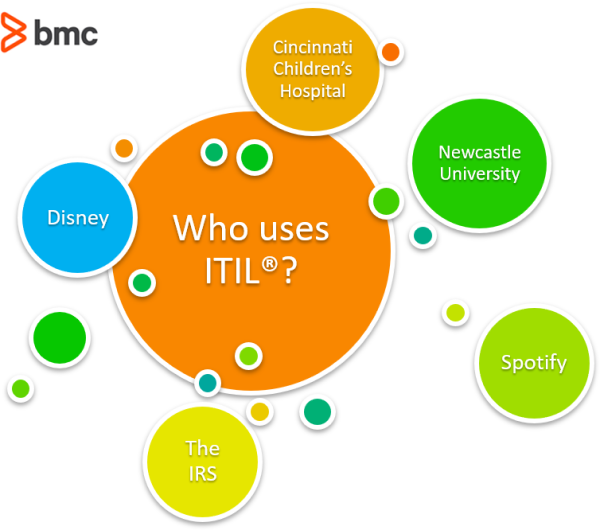ITIL® is a set of practices that imparts practical and strategic ITSM guidance. (The latest version is ITIL 4.) ITIL is used as a guide to help groups improve the value of their services by focusing on co-creating business value and solving business issues, rather than just improving IT capabilities. Organizations use ITIL as a framework for focusing all their activities, components, and resources to implement capabilities that provide specific business value.
For all the guidance ITIL provides, it’s important to remember that ITIL is a framework that real companies and organizations of all sizes and missions use. Let’s take a look.

Who uses ITIL in 2020?
ITIL can benefit any organization that provides an IT service management (ITSM) product or service. ITIL is used by organizations worldwide in all industries and sectors:
- Large, medium, and small companies
- National, state, and local governments
- Universities and education systems
- Non-governmental organizations
Even though ITIL is used worldwide, it is hard to find a definitive list of global ITIL organizations. However, there is one organization that regularly publishes information on companies that use ITIL: AXELOS. AXELOS owns ITIL and provides a range of best practice solutions and puts out blog posts, case studies, white papers, and Webinars promoting their solutions, including ITIL.
When you want to find out “Who’s using ITIL?”, go to the AXELOS Content Hub and search for case studies containing the search term ITIL. Each case study will reference a specific business using the framework. You can also find a list of ITIL case studies by searching the internet for “ITIL Case Studies”. Using either technique creates a list of organizations in many different industries that use ITIL.
Companies and organizations who use ITIL
Here are 20 different organizations that I found use ITIL and the industries they serve.
- Amadeus, business solution provider for airlines and airports
- Aquilla Heywood, software provider
- Cincinnati Children’s Medical Hospital, healthcare
- De Montfort University, higher education
- Equinor, energy
- Essex County Council, municipal government
- Group Bimbo, international bakery
- Ho Chi Min Securities Corporation, brokerage and equity firm
- Internal Revenue Service, government agency
- Intrinsic, business communications
- LV, Insurance
- Mercantil Bank, banking
- Newcastle University, higher education
- NNIT, internal IT department of Novo Nordisk, pharmaceuticals
- Ohio State University, higher education
- OKD, HBZS, mining rescue services
- Spotify, music streaming
- Sutter Health, healthcare
- US Department of the Interior, government agency
- Walt Disney Company, media and entertainment
Searching for ITIL-enabled organizations this way provides a broad cross-section of organizations you can reference as you put together your own ITIL plans.
ITIL best practices
It is important to evaluate and apply ITIL guidelines in a way that fits the unique qualities and parameters of its business. Used wisely, the benefits achieved can include cost reduction by optimizing use of resources, improved service delivery and customer satisfaction, and a stronger alignment between IT and business groups.
Since ITIL is a set of best practices and not a standard, organizations are free to adopt as much of the ITIL framework as is valuable to them. However, the more ITIL-compliant an organization’s processes are, the greater the benefits that organization will realize.
Additional resources
For more on ITIL and other ITSM practices, check out the BMC Service Management Blog or explore these articles:






